Warsaw Uprising
![]()
The title of this article is ambiguous. For other meanings, see Warsaw Uprising (disambiguation).
Warsaw Uprising
Part of: Action Burza, World War II
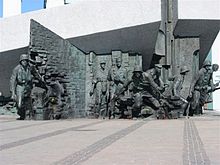
Monument of the Warsaw Uprising
The Warsaw Uprising was the military uprising of the Polish Home Army (Armia Krajowa, AK for short) against the German occupying forces in World War II in Warsaw from 1 August to 2 October 1944. Ordered by the Polish government-in-exile in London as part of the nationwide Aktion Burza, it was, along with the Slovak National Uprising, the largest uprising against the National Socialist system of rule in East Central Europe. The resisters fought the occupying forces for 63 days before surrendering in the face of a hopeless situation. The German troops committed mass murders among the civilian population, and the city was almost completely destroyed after the uprising. The question why the Red Army standing on the other side of the Vistula - except for the 1st Polish Army - did not intervene in the fighting is controversial among historians.
Previous story
Situation in Poland
→ Main article: German occupation of Poland 1939-1945
After the Polish army was crushed by the German invasion in September 1939, German and Soviet troops occupied the country in accordance with the Hitler-Stalin Pact. The western part fell to the German Reich, the eastern part to the Soviet Union.
From the very beginning, German dealings with the defeated were governed by National Socialist racial policy. West Prussia, East Upper Silesia, the Wartheland and the administrative district of Zichenau were annexed and incorporated into the German Reich as new Reichsgaue or attached to already existing Reichsgaue. The annexed territories included parts of Poland that had never belonged to Germany before and were predominantly Polish populated. The remaining part of Poland under German occupation was under German administration as the Generalgouvernement. The main goal was the economic exploitation and oppression of the Polish population. At the beginning, the German repressions mainly affected intellectuals and Poles of Jewish descent. Thus, mass shootings and mass arrests were organized among the country's educated elite in the so-called Intelligenzaktion. The Jews were ghettoized and thus separated from the rest of the population. Education and the press were cut back to a minimum in order to cement the oppression of the Slav population. A note by SS chief Himmler states:
"A fundamental question in the solution of all these problems is the school question, and with it the sifting and screening of the youth. For the non-German population of the East there must be no higher school than the four-class elementary school. The aim of this elementary school has merely to be: simple arithmetic up to a maximum of 500, writing of the name, a teaching that it is a divine command to be obedient to the Germans, and to be honest, industrious, and well-behaved. Reading I do not consider necessary. Apart from this school, there must be no school at all in the East [...]. The population of the Generalgouvernement will then inevitably, after a consistent implementation of these measures, in the course of the next ten years, be composed of a remaining inferior population [...]. This population will be available as a leaderless labor force and will provide Germany with migrant workers and laborers for special work deposits (roads, quarries, buildings) every year."
Likewise, industry was expropriated and some 900,000 Poles were deported to the Reich as forced laborers. Through the introduction of special courts of the occupying power, the Poles were degraded to completely lawless subjects in their own country. In his Reichstag speech of October 6, 1939, Hitler had already announced that major resettlements would have to take place in order to bring back to the Reich German ethnic groups that had been fragmented in Eastern Europe. On the basis of state treaties, ethnic German populations were resettled in two waves of emigration from Volhynia, Eastern Galicia, Bukovina, and Bessarabia, as well as mainly from the Baltic States, and resettled in the Wartheland. To this end, space was created in the Warthegau by order of the authorities through the ruthless transfer of 1.2 million Poles and 300,000 Jews to the Generalgouvernement under forms which were later to have repercussions on the German ethnic groups.
In the course of the war, the Generalgouvernement also became a major site of the Holocaust. A total of 2.7 million Polish citizens of Jewish descent perished in industrialized mass murder. The German Governor General Hans Frank said to a journalist as early as February 1940: "In Prague, for example, large red posters were posted which read that 7 Czechs had been shot today. Then I said to myself; if I wanted to have a poster put up for every 7 Poles shot, the forests of Poland would not be sufficient to produce the paper for such posters."
The USSR initiated a policy of Sovietization in occupied eastern Poland from 1939 to 1941. The most prominent features of this project were land reform, forced collectivization, the dissolution of social associations and the nationalization of industry. This transformation, modelled on the communist state, was accompanied by repression of the population. Shootings, arrests and convictions were followed by mass deportations to penal camps on Soviet soil. These repressions followed a social pattern. The Soviet authorities particularly targeted landowners, former state employees, entrepreneurs, politicians from non-communist parties, priests and intellectuals. Estimates of the number of people deported range from 700,000 to 1.8 million.
Polish Government in Exile
→ Main article: Polish government in exile
After their country was militarily defeated and divided, about 85,000 Polish soldiers and officers, as well as a large number of Polish politicians, managed to flee to France. Other parts of the Polish military, together with Polish President Ignacy Mościcki and the Commander-in-Chief of the Armed Forces, fled to Romania, where both politicians were interned and the soldiers disarmed. In the event that the president was no longer able to exercise his office, the Polish constitution provided for the transfer of governmental power; for this reason Ignacy Mościcki appointed Władysław Raczkiewicz, who was in France, as his successor. The latter formed a new government from the members of the largest political parties who had fled to France, with General Władysław Sikorski at its head and General Kazimierz Sosnkowski as his deputy. Thus, on September 30, 1939, the Polish government-in-exile in France had come into being, and was immediately recognized by the government of France, and shortly thereafter by the governments of Great Britain and the United States, as the only legitimate Polish government. After the defeat of France in 1940, this government and part of the military fled to London.
Resistance and underground state
→ Main article: Polish underground state
As a result of the oppression by the Germans, an underground Polish state was quickly formed, following the long tradition of Polish resistance against foreign occupiers during the partitions of Poland. A secret press and social welfare system was organized, as were "illegal" universities. The funds for this came from the population itself or from funds smuggled in from London. This civilian arm of the resistance passed seamlessly into the building up of armed formations. The Polish military had already formed the underground organization Służba Zwycięstwu Polsce (Service for the Victory of Poland, SZP) on September 27, 1939, shortly before the surrender and even before the emergence of the government-in-exile. Furthermore, other resistance groups formed spontaneously weeks after the defeat of the regular army. They were mainly drawn from the reservoir of former officers and civil servants, as well as from the youth organisations of the parties. Scout organizations (Szare Szeregi) in particular later provided a large, and often particularly motivated, portion of the recruits for the resistance.
The Polish resistance subordinated itself to the government in exile, as it saw itself from the beginning as a continuation of the Second Republic. The government in exile endeavoured to unite all these resistance groups, so that by the turn of the year 1943/44 the ZWZ (Polish: Związek Walki Zbrojnej; Engl: Association for the Armed Struggle) was formed, which united the largest part of the Polish resistance. The united resistance was later called Armia Krajowa (Engl.: Home Army; abbreviation: AK). In 1944 it comprised a total of about 300,000-350,000 members. Only the forces of the extreme right and the extreme left remained outside this alliance: On the one hand, the right-wing nationalist-anti-communist NSZ militia, which in some cases even cooperated with the German occupiers but had only about 35,000 supporters; on the other hand, the communist Armia Ludowa (Engl.: People's Army; abbreviation: AL), which tried to build itself up as a counterpart to the AK after the invasion of the Soviet Union. It reached up to 100,000 members.
London and the AK leadership in Poland agreed that the main tasks of the resistance should be to carry out espionage work for the Allies, to damage German armaments and transport by acts of sabotage, and to retaliate for particularly brutal actions by the occupier. One did not want to carry out open warlike actions at first. On the one hand, because of the low military strength of the ZWZ at the beginning, on the other hand, in order not to provoke any repression of the civilian population on the part of the German occupiers. The commander of the ZWZ in the underground, Colonel Stefan Rowecki wrote in November 1939: "The resistance can only appear openly when Germany collapses, or at least one leg folds. Then we should be able to cut veins and tendons in the second leg so that the German colossus falls over.
The resistance radicalized only when it was realized that its "moderate" appearance had no influence on the radical oppression and extermination of Poles and Jews by the German occupiers. In 1943, the Kedyw was established as an organization for sabotage and acts of diversion. Under its aegis, arson attacks, acts of diversion, prisoner liberations, and even attacks on SS leaders were planned and carried out. The resistance was in contact with the Polish government in exile through couriers and was supported by it financially and - to a lesser extent - with weapons. The resistance also carried out large-scale espionage operations in the service of the Allies. In July 1944, for example, a dismantled V2 rocket captured by Polish resistance fighters was flown out to England by the RAF. During the Warsaw Ghetto uprising in the summer of 1943, fighters from the Home Army tried to organize help.
Diplomacy and politics
The Polish government found itself in a difficult area of tension within the alliance. Its only assets after defeat were the Polish troops fighting on the Western Front. Even before the war began, the British government made it clear to the Poles that their guarantees as allies extended only against the German Reich, not the Soviet Union. With this step Chamberlain wanted to secure Stalin's neutrality in the war. In 1941, Poland's influence within the Alliance reached a low point due to the German invasion of the Soviet Union and the entry of the United States into the war. In the Polish-Soviet treaty of 30 July 1941, the Soviet government declared the Hitler-Stalin Pact null and void, but it gave no assurance of the return of annexed territories. The British secret service SOE, at the government's insistence, concluded an agreement with the Soviet secret police NKVD that curtailed the number of arms deliveries to the Polish resistance. The AK thus received about 600 tons of material between 1941 and 1944, while the Greek resistance received about 6000 tons and the French resistance about 10,500 tons.
The only real ray of hope was the creation of a Polish army in Russia from the formerly deported Polish nationals (Anders Army). Already in October, however, a scandal followed when the British ambassador in Moscow presented a memorandum which assured the Soviet Union sovereign rights over the Baltic States and the annexed part of Poland. The strained Polish-Soviet relationship was further strained by problems in the formation of the Anders Army. The soldiers complained about lack of food supply and armament. Furthermore, recruits from formerly Soviet-occupied eastern Poland were not admitted if they were Belarusian, Ukrainian or of Jewish descent. In 1942, the army was then transferred to British territories via Persia.
In January 1941, the Soviet Union put together a Communist counter-organization to the government-in-exile in the form of the League of Polish Patriots (Polish: Związek Patriotów Polskich; abbreviation: ZPP). In addition, the communist Polish Workers' Party with its AL militia had existed in the Polish underground since 1942. The final break between Stalin and Sikorski was caused by the announcement of the Katyn massacre by German propaganda agencies in 1943. 14,552 Polish prisoners of war, mainly officers, soldiers, reservists, policemen and intellectuals had been abducted by the Soviet NKVD in September 1939 and were considered missing since then. The Polish government believed the German reports and asked the Red Cross to investigate. Out of 4363 exhumed bodies, 2730 were identified as Polish soldiers, all of whom had been shot in the neck. Thus the fate of a part of the prisoners of war was clarified. Following this incident, Soviet Foreign Minister Molotov severed diplomatic relations with the government-in-exile in April 1943 after Sikorski deemed further cooperation impossible due to what had occurred. Furthermore, the Soviet leadership intensified its efforts to establish the ZPP as a counter-government and raised the 1st Polish Army under Soviet command under General Zygmunt Berling.
During this time of crisis, the Polish head of state Sikorski died under unexplained circumstances in an air accident near Gibraltar - and the government-in-exile thus lost a figure of integration and leadership. Against its better judgment, the British government described the massacre of the allied officers as a German crime.
Insurgency Planning
On 20 November 1943, the AK leadership under Bór-Komorowski formulated a first plan to take military action against the German occupiers. The first draft of Aktion Burza (Thunderstorm) envisaged the activation of larger partisan units in the countryside, which were to form an independent Polish administration after the Germans had been pushed back. In Volhynia this method was to be implemented first. However, the three divisions of the AK there failed to liberate the province from the occupiers. They were pushed off to Polesia and Lublin with heavy losses. Thereupon the AK leadership reconsidered its course of action. Along the Red Army's advance through Poland, from now on the surrounding AK units were to attempt to capture the major cities against the retreating Germans and thus take possession of them before the advancing Soviet troops. However, the method of capturing the cities by attacking from the rural areas alone proved to be a failure. The local AK troops had to rely on cooperation with the Soviet Army to capture the towns. In the liberation of Vilnius on July 13, 6,000 AK soldiers fought side by side with Soviet troops of the 3rd White Russian Front. However, they were disarmed under duress by the Soviet troops already one day later, the officers arrested.
Another touchstone for the AK leadership was the cooperation with the Soviet Army in the Lublin area. There, three divisions of the Home Army fought against the Germans in cooperation with the 2nd Soviet Panzer Army. Lublin lay to the west of the Curzon Line and, unlike Vilna, had not been annexed by the Soviet Union in 1939. Therefore, the AK commanders hoped for a more friendly attitude from the Red Army. However, after the ten days of fighting and the liberation of Lublin, all AK troops were again disarmed by the Soviet troops. The same was repeated at Lviv and Ternopil.
These experiences presented an ambivalent picture for the AK leadership. The resistance fighters could only enter the cities from the countryside with the help of the Red Army. Their help was also accepted, but as soon as the enemy was defeated in a region, the AK troops were disarmed. Notable in this was the silence of the Western powers, who never objected to Stalin disarming the soldiers of their Polish ally. As a result, the AK command came to the decision to make Warsaw itself the site of the uprising. Here the guerrillas themselves operated out of the city. Furthermore, the uprising was to serve as a media-effective demonstration of Polish independence vis-à-vis the Soviet Union. The Soviet side gave the impression that it was friendly to an uprising, despite the disarmament. Radio Moscow broadcast an appeal to the citizens of the city to join the fight against the Germans on July 29.
In terms of personnel, the Home Army (AK) was well equipped with around 45,000 fighters in and around Warsaw. Under the command of the communist Armia Ludowa (AL), there were about 1,300 soldiers in Warsaw who joined the uprising. However, there was a shortage of weapons, equipment and ammunition. Only every fourth fighter of the AK had a firearm at the beginning of the uprising. According to the calculations of the head of the Warsaw Circle of the AK Antoni Chruściel, resources would be enough only for three to four days of offensive combat or two weeks of defensive operations. Lacking their own supplies, AK fighters often helped themselves to captured German uniforms and steel helmets during the uprising. The Polish leadership, however, hoped for air support from the Western Allies and the use of Polish paratroops fighting on the Western Front.
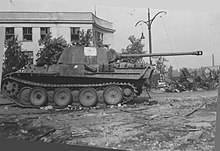
Two Panzerkampfwagen V Panther were used by the Polish Home Army.

Firearms manufactured by the AK in occupied Poland in the Museum of the Warsaw Uprising (2007)

Polish stamp commemorating the 100th birthday of Władysław Sikorski from 1981
Follow
Consequences of the war
In the military and political sense, the insurgency leadership was unable to achieve its goals. The attempt to drive the occupiers out of their own capital failed. Due to the hopelessness of the military situation, the uprising did not strengthen the position of the government-in-exile vis-à-vis the Soviet Union, but rather weakened it, since one had to hope for the help of the Red Army. On the Polish side, some 15,000 soldiers died and 25,000 were wounded. Estimates for the civilian population range from 150,000 to 225,000 dead civilians. This mass suffering of the civilian population made the government-in-exile and the insurgency leadership the target of criticism from their own camp, as well as from their communist rivals.
The German side was also unable to achieve its initial goals, as a quick suppression of the uprising failed and the resistance fighters fought against the occupying forces for 63 days. There are two conflicting accounts of the losses suffered by the German forces. Von dem Bach-Zelewski, as the man directly responsible for the operation against the uprising, spoke in his report on the uprising of 10,000 dead, 7,000 missing and 9,000 wounded. The files of the 9th Army Staff recorded 2,000 dead and 7,000 wounded, though these figures do not claim to be exhaustive. However, the fears of the 9th Army High Command, namely of a simultaneous Soviet offensive, did not materialize. Moreover, after the fall of the Old City, the supply lines via Warsaw to the Eastern Front could be restored relatively quickly.
The AK leadership under Bór-Komorowski had largely attempted to comply with the requirements of international war law (open carrying of weapons; armbands as an outward sign of recognition) and therefore claimed combatant status for its soldiers under the Hague Regulations during the surrender negotiations. The same was agreed for the smaller factions including the communist AL. On 30 August, moreover, the Western powers had declared the insurgents to be members of the Allied forces and threatened reprisals if they were not treated as such. The Wehrmacht therefore granted combatant status to all of the approximately 17,000 prisoners taken since the beginning of the uprising (including members of the communist Armia Ludowa). In addition, transport and guarding of combatants and civilians was to be carried out only by regular Wehrmacht units, not by the SS. A problem arose because of the 2000 to 3000 women who were among the prisoners. Previously, fighting women had not been granted combatant status, but according to the surrender negotiations, they were now protected under international war law. In the negotiations, at the request of the Resistance, a passage had been included that allowed women and youth to voluntarily declare themselves civilians. The German prisoner-of-war administration therefore soon began to forcibly transfer women to civilian status, invoking this provision. Only through the protests of the YMCA and the ICRC did the women regain combatant status from December 1944.
Likewise, the resisters had extracted from the German commander von dem Bach-Zelewski the promise to refrain from reprisals against the civilian population. Towards the AK fighters these promises were largely kept, but towards the civilians only partially. The Warsaw population was deported from the city via the transit camp 121 Pruszków. From here, 100,000 Warsaw citizens entered the German Reich as forced laborers after the end of the fighting. Another 60,000 were sent to the Auschwitz, Mauthausen and Ravensbrück concentration camps. After defeating the Polish forces, Heinrich Himmler ordered the complete destruction of the Polish capital. Until the conquest by the Red Army, German troops engaged in demolitions and arson in the city. They concentrated mainly on culturally significant institutions, such as castles, libraries and monuments. As a result of the fighting during the uprising, around a quarter of the pre-war building fabric of the city had been destroyed. Another third fell victim to the German destruction after the surrender. Warsaw was largely uninhabitable at the time of its conquest by the Red Army.
Further development in Poland
On December 31, 1944, the USSR unilaterally recognized the Lublin Committee as the sole legitimate government of Poland. Before that, Polish Prime Minister Mikołajczyk had been successfully pressured by the Western Allies and the Soviet Union to recognize Poland's westward shift. The Soviet side had not waited for his approval anyway. The NKVD had begun the "repatriation" of the Polish population east of the Curzon Line in October 1944. As one of the first Western observers, George Orwell saw Poland's way into a satellite state dependent on the Soviet Union.
"No, the 'Lublin Regime' is no victory for socialism. It is the reduction of Poland to a vassal state ... Woe to those who want to maintain their independent views and policies."
"No, the 'regime of Lublin' is not a victory of socialism. It is the lowering of Poland to a vassal state. ... Distress will be suffered by those who want to retain their independent goals and policies."
This effort to suppress the forces not dependent on Moscow was also strongly directed against the former resistance fighters. When the Red Army also captured the western part of the city on January 17, 1945, as part of the Vistula-Oder operation, the order was given to the NKVD troops who were coming behind to imprison any AK elements that might still be present. Already during the uprising, the Lublin Committee had described the AK in its writings as traitors and as infiltrated by ethnic Germans. The leadership of the Home Army was accused of collaboration with Germany.
In post-war Poland, these tendencies were also quickly pushed forward with the help of the Soviet security services. In June 1945, a show trial was held in Moscow against the last AK commander after Bór-Komorowski Leopold Okulicki and several leaders of Polish parties. Prison sentences ranging from four months to ten years were handed down. Several of those convicted died under unexplained circumstances in Soviet penal camps. This example was also followed by the treatment of ordinary soldiers in Poland itself. Some of them were deported to the Soviet Union or thrown into prison in their home country. In Poland itself, show trials of AK soldiers followed until the 1950s. They were considered outcast soldiers. Furthermore, former resistance fighters were barred from studying and pursuing a professional career in the communist planned economy. Attempts were also made to hijack the memory of the uprising through the policies of the one-party state. In the first post-war years, when Stalinism was imposed in Poland, the uprising was completely ignored by state authorities.
In the course of the thaw period after the death of Stalin, these restrictions were relaxed. On August 1, 1957, the uprising was commemorated for the first time in post-war Poland by the official side. However, the criminalization of the uprising leadership continued in propaganda. However, the government tried to use the uprising for the legitimization of its own ideology by appreciating the achievements of the population and ordinary soldiers. In the 1960s, these tendencies were reinforced when limited nationalist overtones were added to the commemoration of the uprising. The first non-state-controlled discussion of the uprising took place only in samizdat in the era of the Solidarność movement of the 1980s.
The leadership of the Soviet Union, however, kept the Warsaw Uprising in mind. While in the GDR in 1953, in Hungary in 1956, in Czechoslovakia in 1968 Soviet tanks brutally enforced the Moscow party line, Poland was spared Soviet military intervention in the crisis years of 1956, 1970, 1976 and 1980. Thus it was possible for one of the most liberal societies in Eastern Europe to develop in Poland.
Prosecution of war criminals
The prosecution of the German war criminals of Warsaw remained low. Bronislaw Kaminski was shot by the Germans on August 28, 1944, allegedly because of his brutal actions. Oskar Dirlewanger died in French captivity under unexplained circumstances. Erich von dem Bach-Zelewski, who had commanded the fight against the insurgents, was sentenced to life imprisonment in the 1960s in West Germany - but for murders he had ordered as an SS leader before the outbreak of war. After the war, SS officer Heinz Reinefarth became a member of the Schleswig-Holstein state parliament and mayor of Westerland.
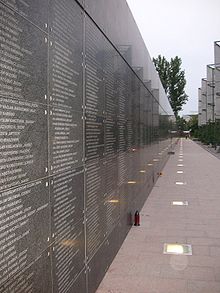
Wall of memory, 2004
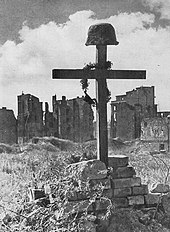
Grave of an insurgent, Warsaw 1945
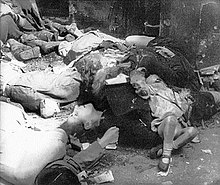
Polish civilians murdered by SS units in August 1944
Questions and Answers
Q: What is the Warsaw Uprising?
A: The Warsaw Uprising was a rebellion by the Polish resistance Home Army against Nazi occupation of Warsaw in 1944.
Q: How long did the uprising last?
A: The uprising lasted for 63 days.
Q: Who were the resistance fighters in the uprising?
A: The resistance fighters were members of the Polish resistance Home Army.
Q: What happened after the uprising?
A: After the uprising, German troops killed many civilians and destroyed almost all of Warsaw.
Q: Why did not Red Army take part in fighting during the Uprising?
A: It is unclear why Red Army did not take part in fighting during the Uprising, but historians have given several theories.
Q: Was there any other European Resistance Movement that was similar to Warsaw Uprising?
A: Yes, there was another European Resistance Movement that was similar to Warsaw Uprising - it was called Slovak National Uprising which happened from 29 August to 28 October 1944.
Search within the encyclopedia